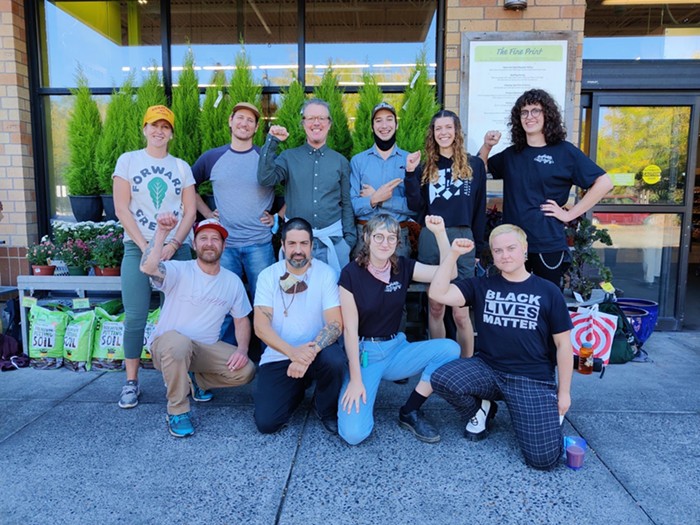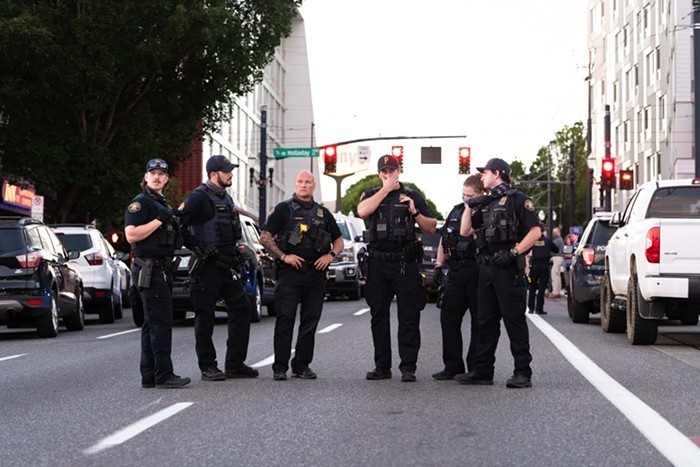
Under the city's proposal, all malted beverages with more than 5.75 percent alcohol would be forbidden in the special zone. All containers larger than 12 ounces—no one saw the light and gave a dispensation for 16-ounce tallboys of regular beer—also would be a no-no. Same with boxed wines, most fortified wines and the shitty wine that comes in those round, fat jugs.
Microbrews, as defined by federal guidelines, would not be included. And, thanks to persistent questioning on the dais from Randy Leonard and Nick Fish (helped by testimony from wine lobbyists and mid-meeting hallway huddles with grocery lobbyist Jim Gilliam), neither will gourmet wines that pack a lot of punch.
The city's petition for the zone heads next to the Oregon Liquor Control Commission. Liquor commissioners, if they agree to look at the petition, will conduct their own research and may draft their own rules. A final decision on a ban, a first for Oregon, is perhaps a year away.
Initially, Fritz's plan—put together by the capable Theresa Marchetti of the Office of Neighborhood Involvement—broadly banned all wines with more than 14 percent alcohol. Instead, commissioners homed in on wines like Mad Dog, which have spirits added to them, with exemptions for fancy fortified stuff like vermouth, marsala, madeira , sherry and port. Parsing the stats used to draw up the proposal, Fish noted high-end wine only accounted for a fraction of overall drinking problems downtown.
"If that language was in there, we would support it," said Gilliam, who wound up being the last person to address the council. Two of his clients, Safeway and Fred Meyer, have stores in the proposed area, and each stock literally scores of wine offerings that otherwise would have been affected.
But why wasn't there any love for cold, frosty tallboys? Find out after the jump.
Oddly, though, no one pounded home the same argument about tallboys of PBR or Budweiser, which similarly account for a far smaller percentage of problems than tallboys of beer stronger than 5.75 percent alcohol, like Milwaukee's Best Ice. Retailers made the point in stakeholder meetings, and almost everyone I've talked to about the proposal—including faithful Mercury commenters—also expressed shock and dismay that tallboys were included. Only Doug Peterson, who owns three markets in the zone, raised the issue at all last night.
After the meeting, I asked Leonard why he didn't step up in similar fashion for beer. "I didn't hear anyone clearly articulate that," he told me. "I needed someone to say, 'Here's where you got this wrong.'"
He almost has a point. Further giving the appearance, at least to some, that this proposal is as class-based as it is health-based, the testimony last night really was wine, wine, wine all the time. Joe Sixpacks didn't show up to talk. Hoity-toity beer drinkers can still get their boutique bottles. And while the wine industry sent a lobbyist all the way from California, no one came to speak for the big breweries.
One group in particular seemed ecstatic about the outcome, besides staffers working for Fritz: Old ladies. More than a dozen of the 50-plus people who filled the chambers were high-pants-wearing condo dwellers who repeated more hyperbole about the ills of their new downtown neighborhood.
Otherwise, even with the exemption carved out and the vote unanimous, there were plenty of complaints.
Merchants like Chris Girard, CEO of Plaid Pantry, repeated his suggestion that the borders be expanded to take in more markets—a complaint echoed by others who said the proposal would just spread the problem to other neighborhoods and send drunks out of the reach of detox workers mostly concentrated downtown.
Many also suggested the ban focus on particular brands, copying the formula used by alcohol bans in Washington state—bans whose success Portland officials have cited.
City officials and police had an easy response to both concerns. Because markets outside downtown aren't packed in shoulder to shoulder, it would be easier to use current city rules to bust whichever problem stores arise, they said. They also said a ban built on alcohol content and container sizes prevents manufacturers from repackaging forbidden brands under new names, and it keeps officials from having to continually watch for new products.
Then there's the bigger picture: Lifting people from the mire of addiction, and the social problems that go hand in hand with it.
"Street drinkers usually suffer from two things: a physical addiction to alcohol, and homelessness," said Rob Wheaton of Oregon AFSCME, speaking on behalf of the Hooper Detox Center. "A meaningful solution is going to require some commitment to treatment and care."
Fritz repeated a familiar line that this was just a "piece of the puzzle." I believe she means that. And maybe it will help. But it's also not enough.
And as much as I wish folks had stepped forward in defense of tallboys, it seems a few more folks should have showed up to pound home this issue, too.












